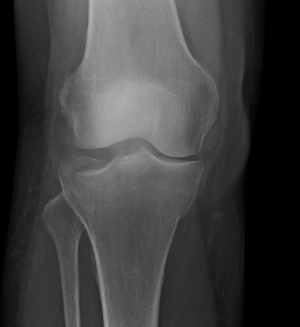
Tibial Plateau Fracture
Fractures that involve the tibial plateau occur when a force drives the lower end of the thighbone (femur) into the soft bone of the tibial plateau, similar to a die punch. The impact often causes the cancellous bone to compress and remain sunken, as if it were a piece of styrofoam that has been stepped on.
The tibial plateau is located on the upper surface of your tibia just below your kneecap. This region of your tibia is prone to fracture in high-impact accidents in sports such as football and skiing, or in car accidents. The tibial plateau is located inside your knee joint capsule, therefore a fracture to this region can also damage structures of your knee. Therefore, rehabilitation from a tibial plateau fracture may involve more than just allowing the bone to heal.
The ligaments and tendons located inside your knee joint capsule may have suffered damage as well, making rehabilitation from a tibial plateau injury more involved. Always seek immediate medical attention after incurring a tibial plateau injury. Stage 1In the first stage of rehabilitation from a tibial plateau fracture, your knee must be immobilized for six to eight weeks to allow your tibial plateau to heal. This is usually done by placing your knee in a cast or solid brace. Like any bone fracture, you must allow the bone to heal by keeping it still.
Failure to properly immobilize your knee after a tibial plateau fracture may result in a non-union fracture in which your bone will not heal properly, or the healing process will be significantly delayed. Stage 2Once your tibial plateau has fused together, your cast or hard brace may be removed. This marks the end of the first stage of rehab and the beginning of the second. In this stage, you will attempt to regain range of motion in your knee with flexibility training.
Flexibility training may involve passive and active stretching. Passive and active stretching are techniques used by physical therapists to regain range of motion in your knee following months of immobilization. In passive stretching, a physical therapist will manually move your knee in different directions while you lie or sit passively on a table. In active stretching, you will move your knee through its range of motion under your own power. Stage 3As you begin to regain range of motion in your knee joint, it is also necessary to strengthen the muscles that support your knee.
After months of immobilization following a tibial plateau fracture, the muscles that support your knee will atrophy, or lose size and strength. Because a tibial plateau fracture is often associated with other joint capsule injuries, every muscle that crosses your knee joint should be strengthened to increase the stability of your joint capsule. This includes your hamstrings and calves in addition to your quadriceps. Your physical therapist will direct you through the proper strengthening exercises that are specific to your needs. Stage 4Once your physician has determined that your tibia bone has completely fused and your physical therapist has determined that you have regained adequate range of motion and strength around your knee, you may return to normal activity. However, your physical therapist may require that you continue the range of motion and strength training exercises you completed during stages two and three of your rehabilitation to maintain flexibility and strength.
This may protect your tibial plateau and knee joint capsule from re-injury and ensure long-term recovery. The tibial plateau is located on the upper surface of your tibia just below your kneecap. Always seek immediate medical attention after incurring a tibial plateau injury. In the first stage of rehabilitation from a tibial plateau fracture, your knee must be immobilized for six to eight weeks to allow your tibial plateau to heal. This is usually done by placing your knee in a cast or solid brace. In this stage, you will attempt to regain range of motion in your knee with flexibility training.
Flexibility training may involve passive and active stretching.
